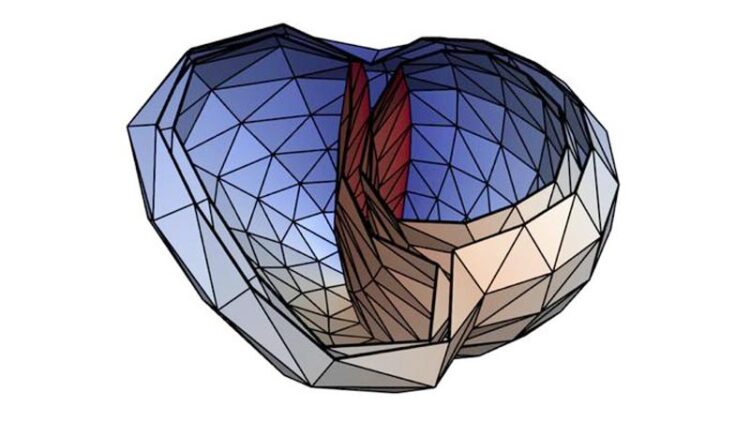Machine learning: artificial neural networks localize extrasystoles

Coordinate representation of the ventricles.
Graphics: Dr. Axel Loewe, KIT
KIT researchers use deep learning for non-invasive localization of ventricular extrasystoles.
Worldwide, cardiovascular diseases cause more than 17 million deaths per year. Of these, about 25 percent are deemed sudden cardiac deaths. They may be caused by ventricular tachycardias, i.e. quick cardiac dysrhythmias from the ventricles that are frequently caused by ventricular extrasystoles. These additional heartbeats from the heart chambers feel like skipped heartbeats. Normal heartbeat is controlled by the sino-atrial node in the left atrium. Extrasystoles, by contrast, are caused by electrical signal sources at other places. Up to a certain number, ventricular extrasystoles are normal. Ventricular tachycardias, however, may impair cardiac action and even be life-threatening in case of existing cardiac insufficiency.
Ventricular tachycardias may be treated by catheter ablation: The origin of the extrasystoles is ablated by high-frequency current via a special catheter. For this, the origin must be localized precisely. Methods to insert a catheter into the ventricle for localization are minimally invasive, but time-consuming and associated with certain risks. Localization based on an electrocardiogram (ECG) requires prior acquisition of the patient-specific geometry with the help of tomographic imaging. “Machine learning methods, by contrast, enable identification of the origin of extrasystoles in a non-invasive manner and without tomographic imaging,” says Dr. Axel Loewe, Head of the interdisciplinary Computational Cardiac Modeling Group at KIT’s Institute of Biomedical Engineering (IBT).
Neural Networks Learn from 1.8 Million ECGs
In Artificial Intelligence in Medicine, researchers from IBT and from the company of EPIQure in Karlsruhe report how they use deep learning to localize ventricular extrasystoles from ECG signals without patient-specific geometries. For this purpose, the researchers use convolutional neural networks (CNNs). This is a special type of artificial neural networks, which is composed of various layers with different tasks. CNNs are suited for high data volumes and can be trained comparably quickly.
The researchers trained the CNNs with synthetic data obtained from a realistic simulation model exclusively. This was the only way to generate a data set of 1.8 million extrasystole ECGs. Finally, they evaluated their method using clinical data. In 82 percent of all clinical cases, the origin of the extrasystoles had been determined correctly. “Following further optimization using clinical data, our method will have the potential to accelerate medical interventions, reduce risks, and improve results,” Loewe says.
Original Publication
Nicolas Pilia, Steffen Schuler, Maike Rees, Gerald Moik, Danila Potyagaylo, Olaf Dössel, and Axel Loewe: Non-invasive Localization of the Ventricular Excitation Origin Without Patient-specific Geometries Using Deep Learning. Artificial Intelligence in Medicine, 2023. DOI: 10.1016/j.artmed.2023.102619
https://doi.org/10.1016/j.artmed.2023.102619
More Information on the Computational Cardiac Modeling Group at KIT
Being “The Research University in the Helmholtz Association”, KIT creates and imparts knowledge for the society and the environment. It is the objective to make significant contributions to the global challenges in the fields of energy, mobility, and information. For this, about 9,800 employees cooperate in a broad range of disciplines in natural sciences, engineering sciences, economics, and the humanities and social sciences. KIT prepares its 22,300 students for responsible tasks in society, industry, and science by offering research-based study programs. Innovation efforts at KIT build a bridge between important scientific findings and their application for the benefit of society, economic prosperity, and the preservation of our natural basis of life. KIT is one of the German universities of excellence.
Journal: Artificial Intelligence in Medicine
DOI: 10.1016/j.artmed.2023.102619
Method of Research: Computational simulation/modeling
Subject of Research: Not applicable
Article Title: Non-invasive localization of the ventricular excitation origin without patient-specific geometries using deep learning
Article Publication Date: 1-Jul-2023
COI Statement: All authors have no conflicts of interest to disclose.
Media Contact
All latest news from the category: Information Technology
Here you can find a summary of innovations in the fields of information and data processing and up-to-date developments on IT equipment and hardware.
This area covers topics such as IT services, IT architectures, IT management and telecommunications.
Newest articles

Innovative 3D printed scaffolds offer new hope for bone healing
Researchers at the Institute for Bioengineering of Catalonia have developed novel 3D printed PLA-CaP scaffolds that promote blood vessel formation, ensuring better healing and regeneration of bone tissue. Bone is…

The surprising role of gut infection in Alzheimer’s disease
ASU- and Banner Alzheimer’s Institute-led study implicates link between a common virus and the disease, which travels from the gut to the brain and may be a target for antiviral…

Molecular gardening: New enzymes discovered for protein modification pruning
How deubiquitinases USP53 and USP54 cleave long polyubiquitin chains and how the former is linked to liver disease in children. Deubiquitinases (DUBs) are enzymes used by cells to trim protein…



